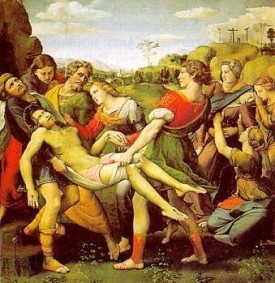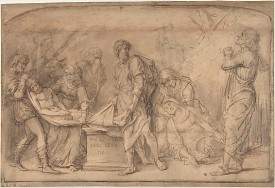The Entombment embodies overwhelming spiritual grief. Ten stricken figures are ranged horizontally, like an antique frieze, against a stark, rocky landscape. At far left, Nicodemus strains under the weight of Christ’s upper body as he maneuvers the corpse, wrapped in a loin cloth, toward a sarcophagus. Mary Magdalene, her arms flung out, her head down, wails in agony. An older woman, wearing a pained expression, helps guide the lifeless body, while a male youth near the mouth of the burial cave covers his tearful face with the edge of his robes.
Joseph of Arimathaea, standing before the cave’s entrance and bearing Christ’s body at the feet, is the composition’s fulcrum. With his face a picture of absolute despondence, and his fluttering robes seeming to echo his inner turmoil, he twists away from the corpse and toward the figures at the right—as if he cannot bear to confront Christ’s death. At right, the collapsed Virgin Mary is supported by two kneeling women; their limp forms contrast with the upright stiffness of a despairing Saint John, his mouth agape in a howl of sorrow. In the background, we see the lonely crosses and the curving, rutted road the burial party has followed from crucifixion to cave.








